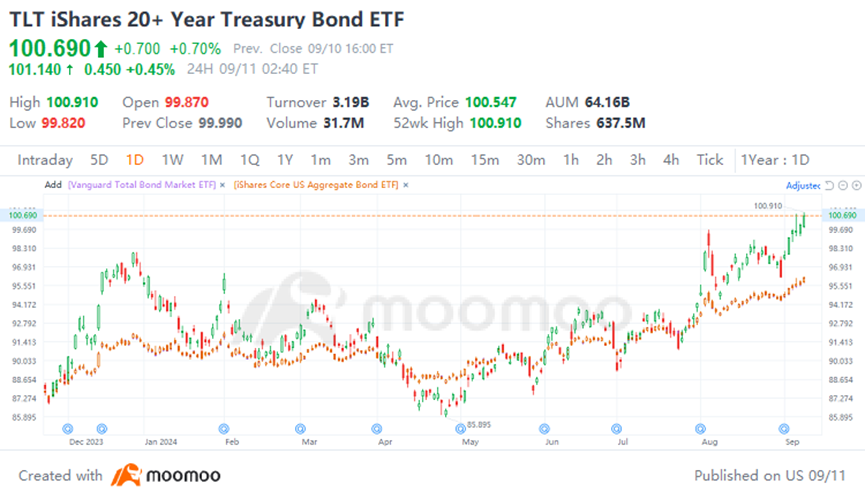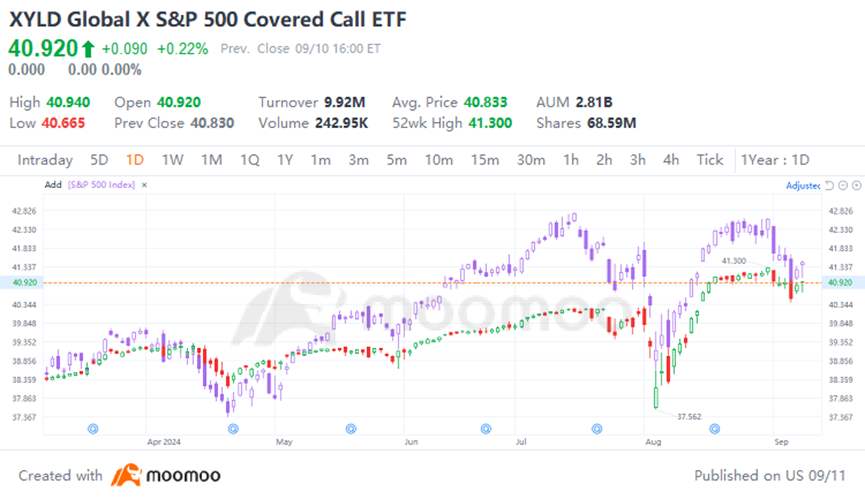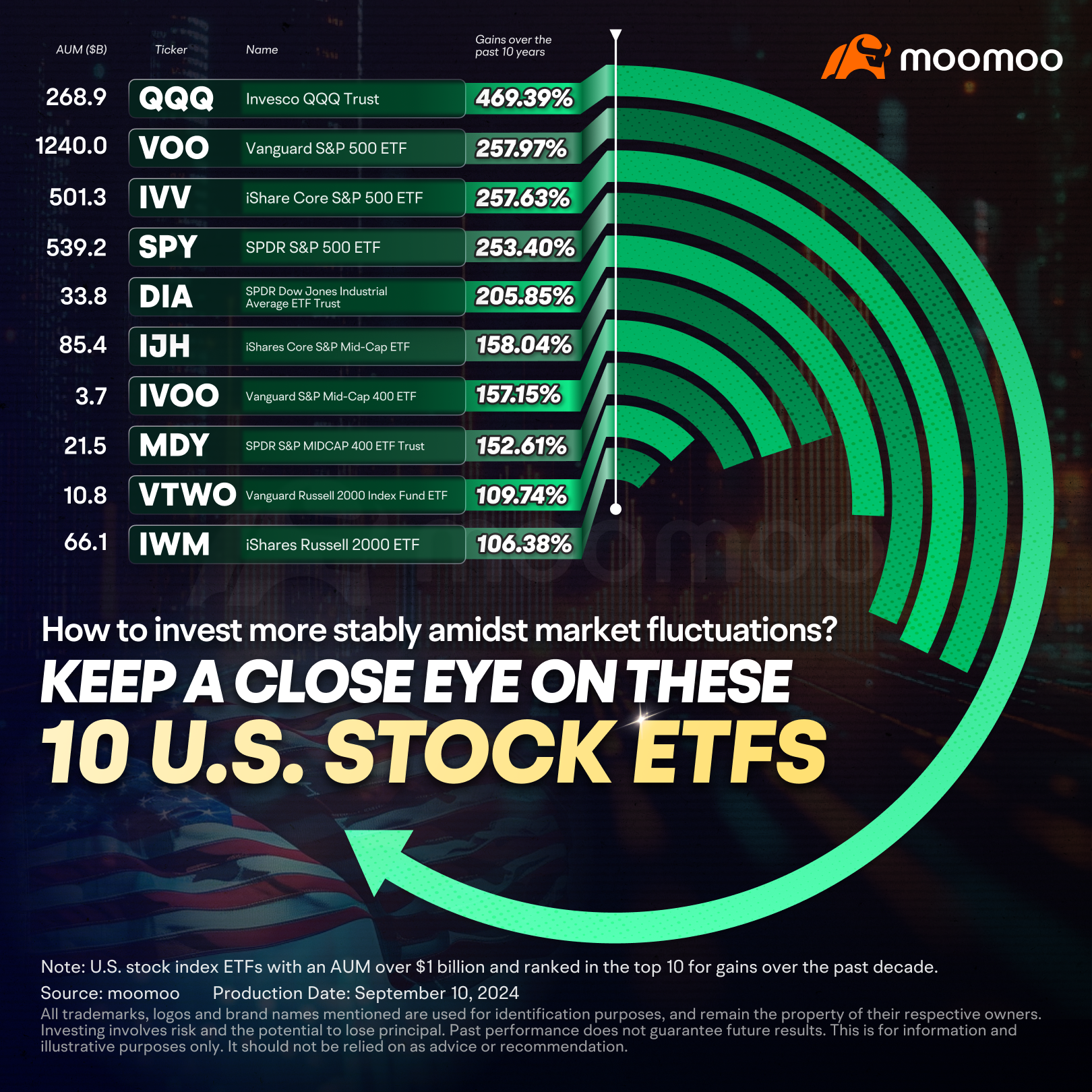Recently, market volatility has intensified due to CPI data, Federal Reserve FOMC meetings, and the upcoming U.S. presidential election, which could further increase volatility. In this context, investors looking to devise investment strategies can start with three types of ETFs: bond ETFs, options income funds, and index ETFs that are bought on dips and held over the long term.
Bond ETFs
A snapshot of ETF flows by Eric Balchunas of Bloomberg Intelligence shows bond ETFs as the only category with net inflows since the start of the month.
 The $119 billion $iShares Core US Aggregate Bond ETF (AGG.US)$ has received $1.3 billion worth of inflows so far this month. And the $116 billion $Vanguard Total Bond Market ETF (BND.US)$ has generated more than $700 million over the same period. Moreover, the bond market proxy, the $iShares 20+ Year Treasury Bond ETF (TLT.US)$, has risen 4.69% in the past five trading days and has topped $100, as the Fed Funds futures market now predicts a 100% chance of a September rate cut.
The $119 billion $iShares Core US Aggregate Bond ETF (AGG.US)$ has received $1.3 billion worth of inflows so far this month. And the $116 billion $Vanguard Total Bond Market ETF (BND.US)$ has generated more than $700 million over the same period. Moreover, the bond market proxy, the $iShares 20+ Year Treasury Bond ETF (TLT.US)$, has risen 4.69% in the past five trading days and has topped $100, as the Fed Funds futures market now predicts a 100% chance of a September rate cut.

Besides, the $Ishares Trust Core Total Usd Bd Mkt (IUSB.US)$and the $iShares 7-10 Year Treasury Bond ETF (IEF.US)$saw inflows of $2.3 billion and $1.6 billion, respectively.
“The role of bond ETFs is two-fold: to generate income and bolster returns during market declines. Additionally, bonds reminded investors of their utility as shock-absorbers, with most fixed income categories losing less ground than the broader stock market.” Barbara Friedberg, investment portfolio manager at Forbes Advisor said.
Option Income Fund
An option income funds generate current income for its investors by earning premiums from selling options contracts. This type of fund experiences smaller losses in the portfolio than the underlying asset when the market declines, but also has limited maximum profit when the market rises.
One way these funds generate income is to sell options strategies that are delta-neutral, meaning that they do not change in value as the market moves either up or down. A short straddle is an options strategy comprised of selling both a call option and a put option with the same strike price and expiration date. A covered call is another common strategy. It includes selling a call option on a stock that is currently being held in the portfolio.
The iShares 20+ Year Treasury Bond BuyWrite Strategy ETF seeks to track the the iShares 20+ Year Treasury Bond ETF while writing (selling) one-month covered call options to generate income. The fund has gained 7.14% since the beginning of the year, outperforming the TLT's increase of 4.55% over the same period.
2. $Global X S&P 500 Covered Call ETF (XYLD.US)$
The Global X S&P 500 Covered Call ETF (XYLD) buys the stocks in the S&P 500 Index and “writes” or “sells” corresponding call options on the same index. This fund's YTD performance has been less than that of the S&P 500 index, but it experienced a smaller decline than the S&P 500 during the early August selloff. The fund may perform well in times of market turbulence.

3. $Global X Nasdaq 100 Covered Call ETF (QYLD.US)$
The Global X Nasdaq 100 Covered Call ETF (QYLD) buys the stocks in the Nasdaq 100 Index and “writes” or “sells” corresponding call options on the same index. Also, During the early August selloff, the fund dropped 7.75% from its high, while the Nasdaq 100 index fell more than 11% during the same period.
Top-performing index funds
Moreover, amid the current market volatility, stable returns can still be achieved through long-term holdings of stock index ETFs.
John Bogle, the founder of Vanguard Group and the "father of index funds," once said that due to huge investment friction costs, the probability of long-term profitability is very low. Therefore, the most effective way to accumulate wealth is to keep pace with the annual return provided by the financial market, and then profit from the long-term investment portfolio. The best strategy is to invest in index funds.

The Invesco QQQ Trust ETF tracks the performance of the largest non-financial companies in the Nasdaq-100 Index, which includes primarily tech companies.
This ETF started trading in 1999, and it’s managed by Invesco, a fund giant. This fund is the top-performing US stock index ETF in terms of total return over the past 10 years as of September 10, 2023, with a gain of 469.39%.
2.$Vanguard S&P 500 ETF (VOO.US)$
The S&P 500 is one of the most widely-followed stock market indices in the world, and there are many funds that invest based on the index. The Vanguard S&P 500 ETF tracks the S&P 500 index and is one of the largest funds on the market. As of September 10, 2024, the fund’s AUM amounts to $1.24 trillion.
3.$iShares Core S&P 500 ETF (IVV.US)$
The iShares Core S&P 500 ETF is a fund sponsored by one of the largest fund companies, BlackRock. This iShares fund is one of the largest ETFs. As of September 10, 2024, the fund's assets under management reached $501.3 billion, with a return of 257.63% over the past 10 years.
4. $SPDR S&P 500 ETF (SPY.US)$
The SPDR S&P 500 ETF is the granddaddy of ETFs, having been founded all the way back in 1993. It helped kick off the wave of ETF investing that has become so popular today.
With assets amounting to $539.2 billion, this fund is among the most popular ETFs. It is sponsored by another heavyweight in the industry, State Street Global Advisors, and has achieved a return of 253.4% over the past 10 years.
5.$SPDR Dow Jones Industrial Average Trust (DIA.US)$
Investors don’t have a lot to choose from when it comes to ETFs tracking the Dow Jones Industrial Average, but State Street Global Advisors comes through with this fund that tracks the 30-stock index of large-cap stocks.
This fund is definitely one of the earlier ETFs, having debuted in 1998, and manages over $33.8 billion in assets. It has achieved a total return of 205.85% over the past 10 years.
6. $Vanguard Russell 2000 ETF (VTWO.US)$
The Vanguard Russell 2000 ETF tracks the Russell 2000 Index, a collection of about 2,000 of the smallest publicly traded companies in the U.S.
This ETF began trading in 2010 and currently has an asset management scale of $10.8 billion. It has achieved a total return of 106.38% over the past ten years.
Source: Yahoo Finance, Bankrate, Investopedia
